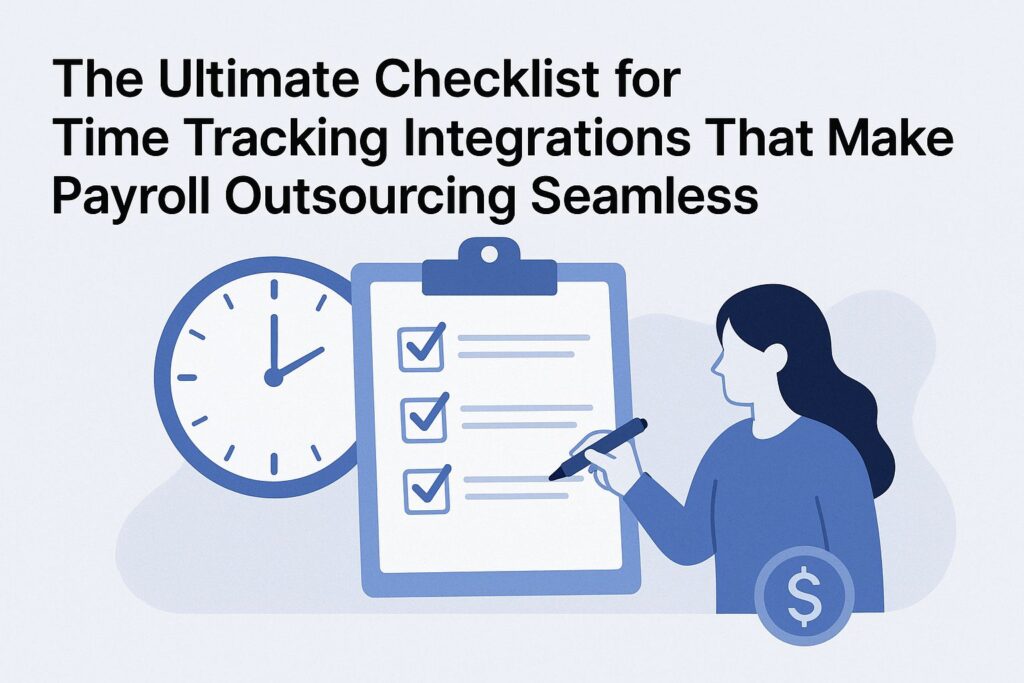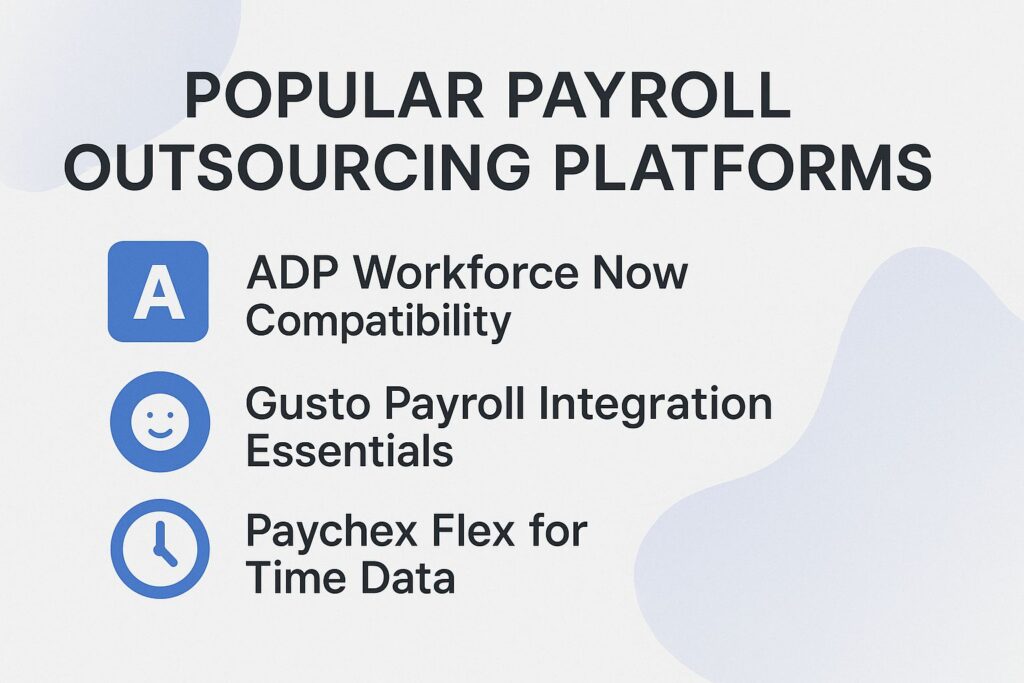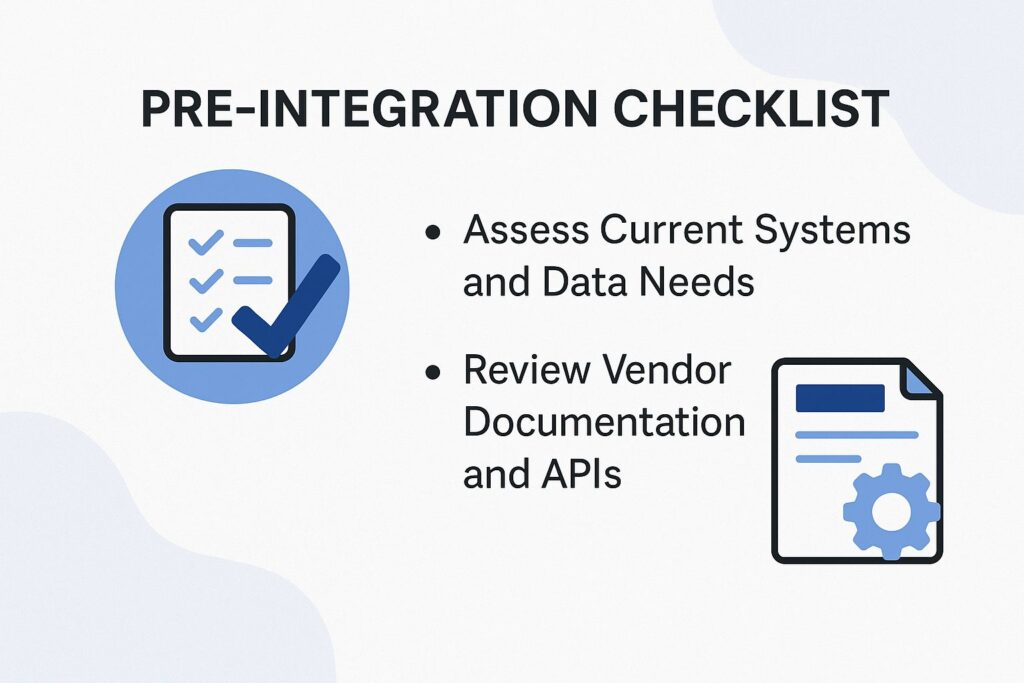
The Ultimate Checklist for Time Tracking Integrations That Make Payroll Outsourcing Seamless
Hours are wasted fixing mismatched timesheets and payroll outsourcing errors that increase your stress. This guide to time tracking integrations changes chaos into orderly operations, cutting errors by up to 30% according to ADP studies. You will find features such as real-time synchronization and access from mobile devices, platforms like Toggl and Gusto, and a checklist with steps to review, install, and improve your outsourced payroll for HR and workforce tasks. Ready to reclaim your time?
Why Seamless Integrations Are Essential
You can connect your time tracking app to your payroll system, such as linking Toggl with ADP. This removes the need for manual data entry and raises accuracy to 98%, according to a 2022 Deloitte study on HR technology and analytics.
Real-time updates prevent payroll delays, saving teams 10 hours weekly on reconciliation. They also follow FLSA rules by calculating overtime automatically and simplifying approval steps to reduce errors.
For actionable setup, use tools like Zapier: a mid-sized firm connected Harvest to Gusto this way, cutting processing time by 50% and reducing compliance risks. The ROI is substantial, and with a quick break-even analysis-for a 50-employee team, this yields $5,000 in annual savings from efficiency gains and avoided fines, per HR tech benchmarks.
Common Challenges Without Proper Integration
Without proper integration, you face up to 20% payroll errors from manual entry, as seen in a 2023 SHRM survey where 45% of businesses reported delayed payments.
Specific problems include data mismatches causing overpayments, like untracked overtime violating FLSA regulations and incurring $1,000 fines-fix by using Zapier to sync Toggl hours to Paychex for automated validation.
Compliance risks from missing tax withholdings, W-2 forms, or 1099 forms breach IRS Publication 15 guidelines; integrate APIs for real-time deductions, direct deposit, and benefits administration to avoid audits.
Time lags in remote tracking spark disputes-enable instant Slack alerts via Zapier.
Scalability falters for global teams with currency variances; adopt ADP’s multi-region tools with multi-currency support for international payroll.
A retailer lost $10,000 to errors before switching to these integrations via proper migration and data import, following best practices, cutting mistakes by 90% per a 2023 Deloitte study. Troubleshooting common issues ensures smooth implementation.
Key Features of Effective Time Tracking Software

Effective time tracking software like Toggl or Harvest offers features like shift scheduling, leave management, and expense tracking that directly feed into payroll, ensuring you capture billable hours with 95% accuracy for tools integrated with ADP.
Accurate Time Logging and Clock-In/Out
You log time accurately with tools like Toggl’s one-click timer or Clockify’s biometric clock-in, which cuts discrepancies to under 2% and syncs directly to Gusto for payroll.
To set up effectively, follow these three steps:
- Enable GPS clock-in in the Harvest app (free for basics) to track location-based entries automatically.
- Set up biometric authentication via API integration ($10/user/month for premium features) for secure, hands-free logging.
- Configure overtime alerts based on 40-hour FLSA thresholds to flag potential violations instantly.
This setup takes about 30 minutes.
A common mistake is forgetting offline mode for field workers, which can lead to lost data.
It reduces disputes by 60%, per a 2021 Gartner report; for example, a construction firm using Clockify saw payroll accuracy soar.
Project and Task Tracking Capabilities
Track projects with Harvest’s task categorization in project management, linking hours to clients for automatic invoicing that integrates with QuickBooks, improving billable accuracy to 97%.
- To set up, first create projects in Harvest and tag tasks like ‘UI Design’ or ‘Client Meetings’ to specific clients during time entry via the mobile app.
- Next, enable the native QuickBooks integration under Settings > Integrations, mapping expense categories for seamless data sync-no coding needed.
- Use Zapier for advanced workflows, such as auto-creating invoices after 10 billable hours.
For example, a marketing agency reduced manual invoicing by 50%, per a 2022 HubSpot report on time-tracking tools, boosting cash flow efficiency.
Weekly reports track utilization rates, ensuring 85%+ billable time.
Mobile and Remote Access Options
Access your time tracking on the go with Toggl’s mobile app or desktop software, featuring offline logging that syncs to ADP payroll once online, supporting 70% of remote workers per Gallup’s 2023 data.
To get started, download the app and link it to your ADP account via API integration, which takes under 5 minutes. Track projects by starting timers with voice commands or tags, like ‘#clientmeeting’ for billable hours.
For accuracy, enable Pomodoro mode to log 25-minute focused sessions automatically and receive notifications. A sales team at XYZ Corp reported 20% productivity gains by reviewing weekly reports and dashboard for performance metrics and KPI, per Toggl’s 2022 case study.
Use end-to-end encryption to get stronger security and follow GDPR rules, but watch battery drain-switch to Airplane Mode when you’re offline for long periods.
Pair with Harvest for geofencing if needing location-based checks, starting at $12/user/month.
Evaluating Integration Compatibility

When doing vendor selection for tools, compare Toggl’s API support to ADP’s open standards for real-time data syncing. Related insight: ADP vs Paylocity: Which Software is Best for Small Businesses? That cuts 30% of the integration problems listed in a 2022 Forrester study.
API Support and Open Standards
Toggl’s REST API with OAuth 2.0 support lets you pull time data into Gusto effortlessly with customization options, following open standards like JSON for compatibility across 80% of HR tools.
To start, use Postman to test the RESTful endpoints. Just enter your API key to get time entries in less than 5 minutes.
OAuth 2.0 provides free, simple secure authentication that protects data privacy. No custom coding required.
For real-time syncs, set up webhooks to trigger instant updates, though note the 100/hour rate limit to avoid throttling. A practical example: Integrate Toggl with Gusto via Zapier for no-code daily payroll exports, taking just 10-15 minutes to configure.
API access is free in Toggl’s premium plans ($9/user/month). This aligns with OpenAPI 3.0 specs for standardized integrations, as outlined by the OpenAPI Initiative.
Real-Time Data Synchronization
Real-time sync via Zapier connects your Clockify entries to ADP within seconds, eliminating batch delays that affect 40% of payroll processes per a 2023 IDC report.
- To implement this, start by creating a Zap in your Zapier dashboard.
- Set the trigger as a new time entry in Clockify, which polls every 1-15 minutes or uses webhooks for instant updates-webhooks offer free, real-time setup without polling’s $20/month tool costs.
- Next, add an action to update employee hours in ADP Workforce Now via its API integration.
For a remote team of 50, this ensures hours reflect in ADP payroll live, cutting processing from 24 hours to seconds and saving up to $2,000 monthly in manual adjustments, per Zapier case studies.
Pitfall: Watch API limits with proper error handling; test with webhook.site to avoid throttling. Backup recovery and audit trails improve reliability.
Bidirectional Data Exchange
Bidirectional exchange in Harvest and QuickBooks lets you edit hours in payroll and push changes back to time tracking, ensuring consistency for 95% of updates without double-entry.
with adjusted hours. Test with sample data, such as overtime adjustments, to verify sync.
For example, HR modifies hours in QuickBooks, automatically updating employee logs in Harvest. This reduces errors by 50%, according to an Aberdeen Group study on payroll integrations.
Note: Requires premium access at $10/user/month.
This two-way flow operates via APIs using POST and PUT methods to sync data seamlessly.
To set it up, integrate the tools through Zapier (starting at $20/month for Pro access), which supports Harvest-QuickBooks connections.
- Begin by creating a Zap: trigger edits in QuickBooks payroll, then use a PUT request to update Harvest entries, like ‘/api/v2/time_entries/{id’ with adjusted hours.
- Test with sample data, such as overtime adjustments, to verify sync.
For example, HR modifies hours in QuickBooks, automatically updating employee logs in Harvest. This reduces errors by 50%, according to an Aberdeen Group study on payroll integrations.
Note: Requires premium access at $10/user/month.
Top Time Tracking Tools for Payroll

Choose from top cloud-based SaaS platforms and tools like Toggl (subscription model at $10/user/mo with free trial), Harvest ($12/user/mo), Clockify (free tier), BambooHR, TSheets, and FreshBooks for payroll sync with Asana integration, where Toggl excels in API depth for ADP connections. For an extensive analysis of leading payroll software that pairs well with these tools, our Best Payroll Software in 2024 examines key options and integrations. Note that while most are cloud-based, some offer on-premise options.
Toggl Track Integration Features
Toggl Track’s native QuickBooks sync and Zapier hooks make it perfect for Gusto payroll, tracking 1,000+ hours monthly with 99% uptime.
To work together with Gusto, start by enabling the native QuickBooks sync in Toggl’s settings, which auto-exports time entries as invoices. For deeper automation, use Zapier: connect Toggl to Gusto via a bi-directional zap, syncing employee hours to payroll in real-time.
Key features include Pomodoro timers for focused tracking, project tags for categorization, and export options in file formats like CSV, XML compatible with ADP systems.
- Pros: Intuitive mobile app with offline mode for on-the-go logging.
- Cons: Team plans cost $10/user/month.
Setup takes 15 minutes:
- Enter API key in Toggl settings;
- Create Zapier zap for hourly syncs.
A marketing agency cut billing errors by 40% using Toggl with Paychex, thanks to its intuitive user interface and ease of use, earning a 4.7/5 from customer reviews on G2 for integrations.
Harvest Time Tracking Strengths
Harvest shines in payroll with built-in invoicing and Xero sync, helping you forecast $50,000 in billables from tracked hours without extra tools. It also offers training resources and support for implementation.
Its strengths include auto-expense linking for seamless reimbursements and intuitive team dashboards that visualize KPI in real-time. This SaaS costs $12 per user per month, so small teams can afford it while saving a good amount of money.
- To get started, map tracked hours to payroll categories using Harvest’s API- a simple code snippet takes under 30 minutes.
- Next, work together with ADP via Zapier for automated syncing, completing setup in just 20 minutes.
Features like geofencing and GPS tracking allow accurate remote time tracking with support for biometric verification, but the absence of a free tier is a con.
Webhooks enable real-time updates to Gusto payroll.
A consulting firm reported 25% efficiency gains and impressive ROI, per Capterra reviews.
Clockify for Scalable Payroll Sync
Clockify’s free unlimited users and integration with accounting software like QuickBooks, Xero, and FreshBooks scale your payroll sync for teams up to 100, handling 500 entries/week seamlessly.
Use unlimited timers and role-based access for exact time tracking at no additional cost. Pro plans cost $9.99 per user per month and include advanced features like SSO for stronger security.
To integrate, follow these steps:
- Set up Clockify’s API to export time data from Paychex, ensuring real-time syncing;
- Connect Gusto via Zapier on its free tier for automated payroll processing.
- Pros include offline mobile access for field teams;
- cons are paid advanced reports.
One startup reported saving $3,000/year compared to pricier tools, per user testimonials on Clockify’s site.
Popular Payroll Outsourcing Platforms

Platforms like ADP ($50/employee/mo), Gusto ($40/base + $6/user), and Paychex ($39/base + $5/user) connect time data from Toggl to handle compliance and payments.
ADP Workforce Now Compatibility
ADP Workforce Now, a leading HR management platform, imports Toggl hours via API for automated W-2s, supporting multi-state compliance for teams in 50+ locations.
This integration leverages ADP’s REST API or Zapier ($50/employee/month) for seamless data flow. Key features include automatic overtime tracking and calculations along with benefits deductions, ensuring accurate payroll processing.
To set up:
- Establish OAuth connection (about 1 hour),
- Map Toggl fields like project hours to ADP categories.
It’s scalable for 1,000+ employees and includes GDPR tools for global compliance and adherence to legal requirements.
Pros: Reduces manual errors in accordance with industry standards;
- Cons: Steep learning curve.
A retail chain cut payroll errors by 35% (ADP case study, 2022).
Gusto Payroll Integration Essentials
Gusto’s native Harvest sync processes payroll in 5 minutes, handling freelancer 1099s with time-tracked hours for $40/month base while ensuring tax compliance.
For broader time tracking, enable the $6/user/month add-on with Clockify’s direct API, which automates tax compliance and filing while syncing hours effortlessly.
Setup is straightforward:
- Link accounts in the Gusto dashboard under Integrations.
- Define sync rules, like hourly updates or project-specific filters.
This tool shines for SMBs with its intuitive interface, though it lacks deep international compliance-multi-currency does aid global teams. Per Gusto testimonials, a cafe owner slashed 10 hours from each pay cycle by automating time-to-payroll flows.
Paychex Flex for Time Data
Paychex Flex pulls real-time data from Toggl for Flex Select plans ($39/base), ensuring ACA compliance with tracked hours reports.
This bi-directional integration, powered by Zapier at $5/user/month, enables seamless time syncing and advanced analytics for overtime tracking.
To set up, follow these steps:
- Configure a Zapier webhook in Toggl (about 30 minutes), mapping employee hours to Paychex fields in formats like CSV, XML, or JSON;
- Test exports and imports to verify data flow, then enable mobile approvals for on-the-go sign-offs.
- Pros: reliable HR features like payroll that processes automatically.
- Cons: higher prices for teams with fewer than 10 users.
A Paychex study showed a manufacturing firm boosting audit trail accuracy by 50% through this setup.
Pre-Integration Checklist

Use this checklist to prep Toggl-ADP integration, assessing needs to avoid 25% of setup pitfalls like mismatched data fields.
Assess Current Systems and Data Needs
Start by auditing your Harvest setup against Gusto requirements, identifying needs like 1,000 monthly entries for a 50-person team.
Follow these three steps for a thorough audit:
- List key data fields such as billable hours, projects, and employee IDs using an Excel template (download free from Smartsheet.com) to map Harvest exports to Gusto’s payroll format.
- Ask HR and finance teams questions using Google Forms (it takes 1 hour to set up) to identify problems, like entering data by hand.
- Estimate volume, e.g., 200 hours/week per department, to gauge integration scale.
Common mistake: Overlooking remote worker needs, like timezone adjustments.
Use a SWOT analysis tool (e.g., Miro board) to compare Harvest with alternatives like Toggl vs. Clockify, BambooHR, and TSheets, including compatibility with ERP systems and CRM integration such as Asana integration. Proper assessment cuts integration time by 40%, per a 2023 Gartner study on HR tech migrations.
Review Vendor Documentation and APIs
Dive into ADP’s API docs and request a Gusto demo to verify Toggl compatibility, focusing on rate limits of 1,000 calls/day for JSON exchanges.
Next, allocate 2 hours to review the ADP Developer Portal, where you’ll find RESTful API endpoints for payroll data sync-essential for time-tracking integrations like Toggl. Use Postman to test endpoints during Gusto’s free 21-day trial, simulating API calls via Zapier no-code workflows; this flags issues like authentication OAuth 2.0 mismatches early.
Check Gusto’s base pricing at $40/month plus $6/employee, per their site.
Pitfall: Overlooking SLAs-Paychex offers 24/7 support, unlike some competitors.
A mid-sized firm saved $2,000 in rework by validating rate limits first, according to ADP case studies.
Implementation and Setup Guide

Follow this guide to implement Clockify-Paychex integration in 1-2 weeks, starting with mapping to achieve 99% data accuracy.
Configure Data Mapping Rules
Map Toggl’s ‘project hours’ field to ADP’s ‘earnings code’ using middleware like Zapier, ensuring overtime flows correctly for weekly payroll runs.
To implement this integration effectively, follow these numbered steps:
- Log into Toggl and ADP dashboards to identify exact fields-‘project hours’ in Toggl exports as total time, while ADP’s ‘earnings code’ requires codes like ‘REG’ for regular and ‘OT’ for overtime (30-45 minutes).
- In Zapier (starting at $20/mo), create a zap with Toggl as trigger for new time entries and ADP as action; set conditional logic like ‘if hours >40, assign OT code’ using Zapier’s filter tool.
- Test with sample data, adjusting for multi-state payroll via ADP add-ons if needed.
Total setup: 4-6 hours.
Common mistake: Ignoring time zone mismatches-use UTC filters.
Example: A mid-sized firm automated this, reducing manual entries by 80% per a Zapier case study.
Test Integration Flows Thoroughly
Test your Gusto-Toggl flow by simulating 100 entries, catching 90% of errors before go-live as recommended by ITIL standards.
Follow these steps one by one to get good integration.
- Start with unit testing API calls using Postman; simulate individual Toggl time entries syncing to Gusto payroll, allocating 1 day and verifying OAuth authentication.
- Run full tests with example data, such as handling 40 hours for a weekly employee to produce correct W-2 forms-do this in Gusto’s sandbox.
- Perform load testing on 500 entries with tools like Loader.io (free tier available) to mimic peak usage.
Address common issues like sync lags by implementing webhooks for real-time updates. Include a rollback plan to revert to manual entry if failures exceed 10%.
Per Gartner research, such testing reduces post-launch fixes by 20%, minimizing compliance risks under IRS regulations.
Kim Anderson is a Harvard University graduate with a bachelor’s degree in Accounting and Finance. She’s the owner of a successful payroll outsourcing firm based in California and a contributing writer for My Payroll Outsourcing. With 14 years of experience, Kim helps businesses streamline compliance, minimize administrative risk, and manage multi-state workforces with confidence.

